Altenheim Historical Highlights
The Altenheim opened in September 1894 December 8, 1886
December 8, 1886
The President of the German General Benevolent Society, Fritz Rosenbaum, appealed to his countrymen to consider building a home where elderly people of German descent (i.e. whose mother tongue was German) would be able to spend the remaining years of their lives.
April 29, 1887
“The Daily Alta California” newspaper reported on April 30, 1887 that the German Benevolent Society had discussed during their quarterly meeting where to build the proposed Altenheim. Suggestions ranged from a site at the German hospital in San Francisco to 17 acres of donated land near San Jose. Site selection and fundraising would be the main focus of members of the association over the next several years.
May 6, 1887
The first meeting of the Altenheim Association took place under the auspices of the German Benevolent Society, Fritz Rosenbaum presiding. It was resolved to erect a home for aged and indigent Germans.
March 31, 1890
The Altenheim Association was officially incorporated with a Constitution and By-Laws adopted under the leadership of Fritz Rosenbaum, president of the Association. Its official name, as filed on March 31, 1890 with the State of California, was “a German Old People’s Home” but the association was also popularly known in the German community as “Deutsches Altenheim von San Francisco”.
July through October, 1890
Discussions were held over the summer and into the fall in order to choose a site for building the new Altenheim. Adolf Sutro offered land in San Francisco near present day City College, and the Committee on Land located suitable property in Fruitvale near Oakland. The Sutro offer apparently entailed purchase of additional, adjoining land. There was considerable back and forth at often contentious meetings regarding which of these two locations would be the best site for building the Altenheim.
October 31, 1890
At a meeting in Druids’ Hall in San Francisco, the association finally decided on the location of the new Altenheim building. Although favoring the Sutro offer initially, the association chose the site in Fruitvale because of the better climate and bucolic setting near a thriving German community. Faced with this decision, those arguing for the Sutro location immediately resigned as directors and members of the association.
May 17, 1891
A picnic was held at the site of the future Altenheim to raise money for the undertaking. As reported in the Chronicle: “ The board of directors of the German Old People’s Home entertained about 600 members of the society [and] their friends. … There among the sturdy oaks, the leafy eucalypti and the tall pines, a happy, jolly crowd gathered yesterday to enjoy a day’s outing and to inspect the site…”
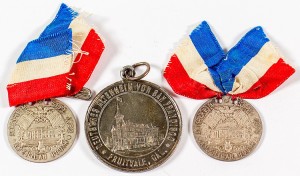 September 20-26, 1892
September 20-26, 1892
The German community of San Francisco and surroundings held a bazaar and fair (Kirmes) at the Mechanics Pavilion in San Francisco in order to raise funds for the construction of the Altenheim in Oakland. On opening day between 5,000 and 6,000 people packed the floor of the Mechanics pavilion. Located throughout the pavilion were various booths, such as the Old German Wine Room (Weinstube), Turkish booth, Japanese Tea booth and the American booth where visitors could purchase food, drinks and an array of items. The women of the Bierstube performed a peasant dance and the fair closed with a ball, also typical for German celebrations of the time. The fair lasted 7 days and was a great success, netting over $32,000 for construction of the Altenheim.
February 15, 1893
Beginning of actual construction of the Altenheim building. Architect: Charles Mau, Contractor: McCann & McCann
August 20, 1893
Laying of the Cornerstone: Several thousand people gathered for the laying of the cornerstone. A band played a march titled “Deutsches Altenheim”, composed for the occasion. F. H. Rosenbaum, president of the Association gave a speech in which he praised the Germans for their progress in building the Altenheim. The following items were buried in a tin box under the cornerstone: Minutes of the first meeting of the Association from 1887; minutes from the incorporation of the Association; photographs of the first board of directors; the constitution and by-laws of the society and various celebratory newspapers in both English and German, chronicling the development of the Altenheim.
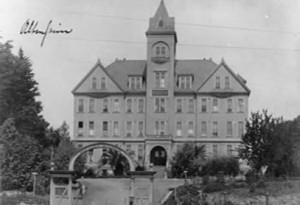 September 15, 1894
September 15, 1894
The Altenheim opened on this day with two residents. By September 22, 12 residents had moved in, according to a report in “The San Francisco Call”.
January 2, 1907
The Altenheim Association (German Old People’s Home) purchased a small, additional parcel on the Western edge of the existing Altenheim property for $10.
July 3, 1908
Fire completely destroyed the building. 
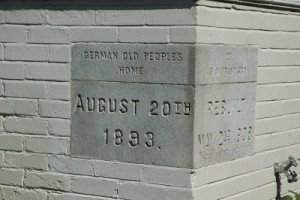 May 2, 1909
May 2, 1909
A large crowd of 10,000 people attended the ceremony of laying the cornerstone of the new Altenheim, exactly 10 months after the original building was destroyed by fire. To raise additional funds, specially prepared bricks with a purchaser’s name inscribed were sold. These bricks can still be viewed on the eastern side of the building. Charles Bundschu, who had a reputation in the German community as the poet of the West coast, presented a poem he had written for the occasion. The new Altenheim building had several fire-reduction measures built into it including the creation of two separate wings to reduce the likelihood of fire spreading from one wing to the other. Additionally, fireproof walls separated the wings from one another. The architect of the new building was Oscar Haupt of Oakland.
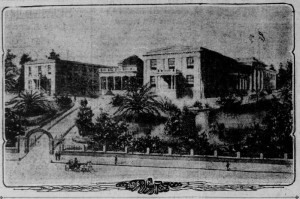 November 28, 1909
November 28, 1909
Dedication and formal opening of the new Altenheim building. Dr. Max Magnus thanked the officials of the German Hospital of San Francisco for taking in residents displaced by the fire. He dramatically described the catastrophic fire of the original building and praised the generosity of the Association members in response to appeals for donations to rebuild the Altenheim. Albert Kayser, Altenheim director and chairman of the building committee, then presented a golden key to C. C. Volberg, the President of the Altenheim.
1909 – 1914
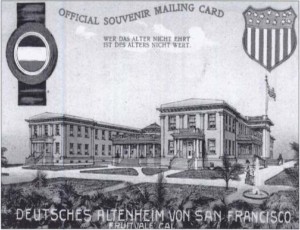 Souvenir postcard of the rebuilt Altenheim building with its prominent two wing design. The new building was constructed at a cost of about $100,000 and was designed to provide lodging for 180 residents. It took less than 17 months to rebuild the Altenheim after destruction of the original building.
Souvenir postcard of the rebuilt Altenheim building with its prominent two wing design. The new building was constructed at a cost of about $100,000 and was designed to provide lodging for 180 residents. It took less than 17 months to rebuild the Altenheim after destruction of the original building.
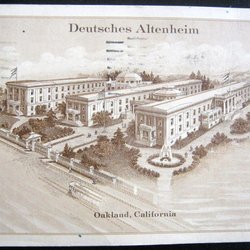 September 1, 1915
September 1, 1915
An additional third wing was added to the rebuilt Altenheim on the Western side of the building under the leadership of Altenheim President, Albert Kayser. Oscar Haupt of Oakland was the architect. This new wing of the building cost about $90,000 to construct.
October 17, 1915
The new wing of the Altenheim was dedicated during a festive celebration.
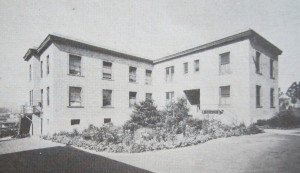 1927
1927
The Excelsior building, with 19 rooms for employees, was constructed. It is now the home of the Excelsior German Center (EGC) and the German School of the East Bay.
June 30, 2002
ALTENHEIM CLOSED. In 2002, after extended efforts to keep the facility open, the Altenheim officially closed. Residents received assistance in finding alternative living accommodations.
2002 – 2005
Committed members of the Altenheim Association lent personal funds to the association in the amount of $400,000 in order to keep the Altenheim open during this period: Lisa Lorenzen, Annemarie Krüger, Gerhard and Astrid Holder, Michael Rombs, Arnold and Edith Steeg, Gus Hofmann, Amandus & Bärbel Steensen, Alfred Langen.
Volunteers of the Altenheim Association donated their time by personally occupying the grounds and buildings of the Altenheim during the day and some nights during this period in order to ensure the protection of the facility. Volunteer guardians of the Altenheim were: Hannelore and Ray Avalos, Gisela and John Binder, Carol and Bill Brady, Heidi Coffin, Gus Hofmann, Marlene and Alois Feuersträter, Harold Wagner, Marie and Alfred Hoffmann, Inge Junginger, Mike Rombs, Bärbel and Amandus Steensen, Barbara Clement and many others…
2005 ‐ 2009
Between 2005 and 2009, Citizens Housing renovated the existing Altenheim buildings and added additional building structures to the Altenheim complex. The name of the association was changed to The Excelsior German Center at the Altenheim.
December 16, 2010
The Excelsior German Center and Eden Housing celebrated the grand opening of the completed Altenheim facility as affordable senior living apartments for Oakland residents.
October 10, 2015
The Excelsior German Center hosts a gala event in celebration of the 125th Anniversary of the founding of the Altenheim Association.
